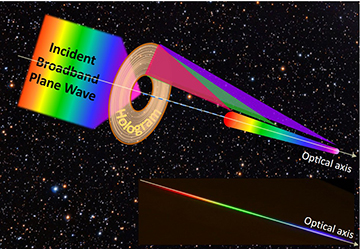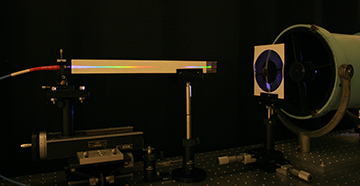A lightweight, flexible lens, developed by RPI scientists for potential next-generation space missions, can either focus light or disperse it, separating it into its constituent colors for high-resolution spectroscopy of exoplanets. [Image: Rensselaer Polytechnic Institute] [Enlarge image]
The nine-year run of NASA’s Kepler space telescope taught us that there are more planets than stars throughout the galaxy. While NASA retired Kepler in 2018, the hunt for habitable planets beyond our solar system continues with missions like the Transiting Exoplanet Survey Satellite (TESS) and the soon-to-be-launched James Webb Space Telescope.
A research team from the United States and Taiwan has developed a lightweight, flexible holographic lens that the researchers believe ideal for the next generation of more powerful, space-based exoplanet telescopes (Sci. Rep., doi: 10.1038/s41598-021-99955-w). Such instruments could be used to directly observe extrasolar planets, a leap over current techniques that detect exoplanets based only on light coming from the star they orbit.
The search for exoplanets
Kepler used transit photometry to find exoplanets, which looks for small dips in the amount of light coming from individual stars caused by planets crossing in front of them. Based on these repeated dips, astronomers can infer a planet’s size, the shape of its orbit and how long it takes to circle its star. Another technique, transit spectroscopy, performed by the Hubble Space Telescope, gathers information about the composition of exoplanet atmospheres from starlight that travels through the atmosphere of an orbiting planet.
The next step forward is for telescopes to seek direct images of exoplanets. But sending such massive telescopes to deep space remains incredibly challenging.
“To find Earth 2.0, we really want to see exoplanets by direct imaging—we need to be able to look at the star and see the planet separate from the star,” said study author Heidi Jo Newberg, a physicist at Rensselaer Polytechnic Institute (RPI). “And for that, we need high resolution and a really big telescope.”
Creating the holographic lens
Newberg and her colleagues, including fellow RPI physicist Shawn-Yu Lin, proposed a lightweight, flexible and foldable holographic lens that makes up the key component in a novel telescope design. The Dual Use Exoplanet Telescope (DUET)—a project in the NASA Innovative Advanced Concepts Program, which funds early-stage technologies—will be able to directly analyze spectra of an exoplanet with extremely high spectral resolution based on diffractive optics.
The optical element consists of a Fresnel hologram based on the interference of two spherical waves. A collimated, diode-pumped-solid-state laser is split into two beams, which are focused with an objective lens and passed through pinholes to produce spherical waves. They propagate along the same optical axis, interfering on a planar photosensitive film and forming the holographic lens.
“Our holographic lens consists of multiple annular rings that focus light onto an optical axis,” said Lin. “So, it is a ‘planar’ lens that can focus and stretch incoming starlight into a straight line.”
“Specifically, in our design, the ring-to-ring spacing can be adjusted so it varies as a function of radius away from the center of the hologram. This new degree-of-freedom allows us to focus different colors of light onto different locations along the optical axis.”
How to stretch light

Schematic diagram of the dual use exoplanet telescope (DUET) based on a Fresnel hologram. [Image: M.-L. Hsieh et al., Nat. Commun., doi: 10.1038/s41598-021-99955-w (2021); CC-BY 4.0]
In other words, says Lin, the optical element is capable of “stretching light” of different colors along the optical axis. The radius of curvature of the two spherical waves can be customized to control the degree of light-stretching. To improve the spectral resolution, one would stretch the light as much as possible. On the other hand, for increasing the sensitivity of light detection, the colors would instead be squeezed tightly along the optical axis.
The researchers tested the properties of the lens using sunlight and a white light LED. The collimated, broadband light was collected through the holographic lens, where different colors were focused on different locations of the optical axis. The experiment revealed an unusually large chromatic dispersion produced by the hologram, as well as sharp spatial intensity distributions for red, green and blue wavelengths.
The result, according to the team, was “a super fine spectral resolution 0.0266 nm at wavelength 515 nm for a detector size of 20 µm.” In light of that, the team concludes, “our proposed DUET can simultaneously perform high resolution spectroscopy, high detection sensitivity and have a low areal mass for space exploration.”

